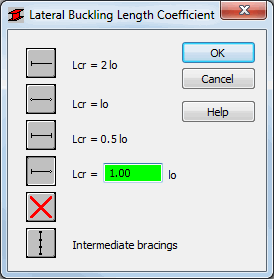Use this option to define the appropriate lengths of bar sections blocked against twisting - of the lateral buckling length. Access the option by clicking one of the following buttons: Upper Flange or Lower Flange located in the Lateral Buckling Parameters field in the Member Definition - Parameters dialog.

Typical lateral buckling models, that determine the relevant values of lateral buckling length coefficients, are located in the displayed dialog. You can identify two buckling lengths as it is possible to fix separately the lower and the upper flange, which results in the appearance of different compressive stresses under various load cases in the upper and the lower flange. It is necessary to provide the coefficient by which the base bar length should be multiplied to obtain the lateral buckling length. The length lz is taken as the base length. The coefficient value can be entered manually or by pressing the typical lateral buckling model icon which assigns the relevant coefficient automatically.
The definition of the lateral buckling length is essential for calculating the lateral buckling length. You can define the lateral buckling length coefficient using the last icon and edit fields.